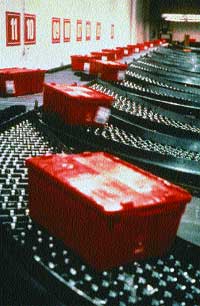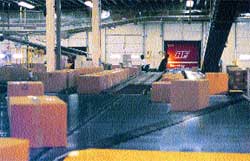Nike DC soars into uncharted production output
March 11, 2015
|
The sliding-shoe sorter picks full shipping cases from the pallet flow racks and single cartons once they have been labeled for shipping. |
Athletic footwear and sports apparel giant Nike, Inc. has gained a worldwide reputation for quality and performance. The Beaverton, OR-based company has enhanced that reputation, at least in part, by aligning itself with world-class athletes: men and women who push themselves to their physical limits.
Nike Tennessee, Inc. has decided to do the same with its throughput, pushing it to the limit at its seven-building, 1.25-million sq-ft distribution center in Memphis. "We measure by unit volume," explains Mark Dennington, director of operations at the distribution center that opened in May, '91. "Through two eight-hour production shifts, we were averaging 350,0000 to 400,000 units of apparel and equipment shipped per day, with a peak of about 550,000.
"We wanted to do more. We've experienced huge growth over the past few years, specifically in our outbound shipping volumes. Consequently, we needed an internal system to help us increase our throughput capacity to one million garments in a 24-hour window."
Essentially, Nike Tennessee was looking to almost double its throughput. Nike found Mathews Conveyor, a member company of FKI Logistex, to achieve this objective. Mathews designs and manufactures complete material handling systems that integrate conveyors, sorters, controls and custom equipment. FKI Logistex was formed in '99 as a complete single-source material handling provider.
Mathews provided Nike Tennessee with a range of new equipment, including live roller conveyor curves, a gravity roller conveyor, a gravity wheel conveyor, a controlled-flow (CFC) zone accumulation conveyor (with sensor rollers), belt merges, live roller merges, sliding shoe slat sorters, swivel wheel diverters and a trash removal conveyor. The new equipment has helped Nike Tennessee achieve its goal of doubling its outbound throughput, and attaining a dramatic 60-percent increase in productivity. Order accuracy has increased to 99.8 percent. Also, Nike Tennessee now has equipment that is more ergonomic and much quieter.
An industry leader
This is now the kind of system befitting an industry leader. In '91, Nike became the world's first sports company to surpass $3 billion in total revenues. And in the years following, the growth in revenues was dramatic; by fiscal year '98, the company boasted revenues approaching $9 billion.
Nike's Tennessee facility serves as a customer service center, handling apparel and equipment distribution. The facility is actually comprised of seven buildings, one of which is dedicated to receiving and to customer/consumer returns; half of the building is pallet storage. Two other buildings are also used for pallet storage, one building is used for carton storage, one for the packing area and value-added services, one for active picking and shipping support, and one for shipping and some carton storage.
The fact that the upgrade included Mathews equipment should come as no surprise. Nike has been using Mathews products since the facility opened in '91. "We had thirteen miles of Mathews conveyor before the new project," says Dennington. "We doubled that to twenty-six miles."
The company also added other material handling equipment, including two large sorters (see PD, Dec., '00, p.52) from Crisplant, Inc., also an FKI member company. The Crisplant sorters interface with the Mathews accumulation conveyor in the staging phase of the order process. The Crisplant tilt tray system, which is in Nike's processing area, is the heart of the operation and the interface.
|
An accumulator moves full-case picks. The live roller conveyor permits accumulation in one direction, without the buildup of line pressure. |
While Dennington says that the company did seek at least one competitive bid from another conveyor supplier, Nike's experience with Mathews made it doubtful Nike would seriously consider anyone else. "We went to a consulting firm to oversee the entire project," remarks Dennington. "We sat down with Mathews and told them our expectations and goals. We asked them very candidly whether they could meet those expectations. It was very unlikely that we would try to integrate equipment from a new material handling equipment provider considering our original equipment. Plus, we've had a long relationship with them, one that we value highly."
Upgrades during business hours
"We didn't shut down; we were continually shipping product," adds Dennington. "The new building helped us establish functional areas to support the business, allowing us to come back into the existing building and retrofit them. We limped along on our 'legacy systems' while we created new systems. This allowed us to go into the older buildings, empty them and have a vacant building for the construction."
But that was just part of the logistical challenges. The fact that a number of vendors had to coordinate their efforts–sometimes working around the clock on very demanding schedules–was particularly challenging.
"We thought Mathews was very creative in how they were able to work around other vendors," Dennington says. "We had multiple vendors working at the same time. We had Crisplant building tilt tray sorters, and Mathews couldn't wait until the sorters were complete. Mathews needed to attach conveyor to the tilt tray sorter at the same time that the tilt tray sorter was being installed."
Training was minimal due to the fact that Nike had used Mathews previously. There was more training for employees who were going to use the automated system. Nike uses a software system from Mathews called the Answer System, which consists of a colored graphics monitoring system.
Mathews' Answer System is a critical part of the material handling function, because it provides carton tracking, graphical representation of the system and divert confirmation. "Our installation is much more dynamic now," Dennington states. "We don't have to do as much preplanning in regard to where things will go with the newer equipment, due to the combination of the software system and the control systems in both the Crisplant and Mathews equipment."
In the new receiving system, for example, there is a sizer. When a case passes through the sizer, it dynamically determines the cube of its case–that is, how many cases can fit on a pallet to fit into a storage position. Nike can maximize space usage in the building by taking advantage of some of the material handling system's unique features.
The other elements provided by Mathews offered equally impressive performance. The company's controlled-flow (CFC) zone accumulation conveyor moves the full-case picks directly to shipping once they have been through a labeling station. This live-roller conveyor permits accumulation in one direction of time without buildup of line pressure. Standard features of the CFC include single-item release, which allows the exit of one load at a time following a electrical remote signal, and multiple-load release, which allows the exit of product in a progressive fashion following a maintained electrical signal. The direction of these conveyors may also be reversed, allowing them to serve as transport conveyors.
Mathews sliding shoe sorter is used to sort full-case picks from the pallet flow racks and single-case areas once they have been labeled for shipping. The sorter features a strong, lightweight design that minimizes switch impact and accelerative loads. Its replaceable polyurethane bumper bands cushion impact and prevent slipback, while the leading edge "plow" design eliminates damaging jams in discharge spurs. The sorter has a sorting capacity of up to 540 ft/min and can sort as many as 230 cases/min based on an 18-in. average case length.
Nike points out that each piece of Mathews equipment has performed extremely well and has been instrumental in helping the Tennessee DC improve quality and productivity. Nike is a company predicated on victory in the retail area, and these DC expenditures make a leap toward that goal.
More information is available:
Conveyors, accumulators: Mathews Conveyor, a member co. of FKI Logistex, 513/874-0788. Circle No. 218.
Sorters: Crisplant, Inc., a member co. of FKI Logistex, 240/629-1300. Circle No. 219.
About the Author(s)
You May Also Like




